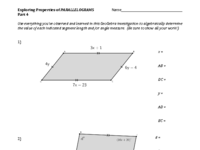
Convex vs. Concave
In the app below, move the vertices of the shown polygon around. Be sure to explore the triangle, quadrilateral, and pentagon. Then, answer the questions that follow.
According to the app, how would you describe what it means for a polygon to be [color=#ff7700][b]convex[/b][/color]? How would you describe what it means for a polygon to be [color=#1e84cc][b]concave[/b][/color]?
Is it ever possible for a triangle to be [color=#1e84cc][b]concave[/b][/color]? Why or why not?
Parallelogram Construction Template & Discovery Lab
STUDENTS:
Use the app below to serve as the template for your i[color=#000000]nvestigation. [br][list][*][color=#0000ff][b][url=https://docs.google.com/document/d/1kVm288vzCFBGaddvBF47MV02L3CtUGf2EFktKT_ybL8/copy]Properties of Parallelograms - Discovery (1)[br][/url][/b][/color][/*][*][color=#0000ff][b][url=https://docs.google.com/document/d/1n9r5jKLFlfQ-RXdnF0Tijm8AeikkAP0_Ojlkt2nZEaE/copy]Properties of Parallelograms - Discovery (2)[br][/url][/b][/color][/*][*][color=#0000ff][url=https://docs.google.com/document/d/1vMHI9WMwe-b0XUU8-8W_pjytuiMJHlUjBfwfdHH3dv8/copy][b]Properties of Parallelograms - Discovery (3)[/b][/url][/color][/*][/list][/color]
Investigative Discovery (Properties of PARALLELOGRAMS) Part 4
Parallelogram: Theorem 2
Interact with the applet below for a few minutes. [br]Then, answer the questions that follow. [br][br]Feel free to move the BIG WHITE POINTS anywhere you'd like! [br][color=#ff00ff]You can also adjust the size of the pink angle by using the slider. [/color]
1.
What special type of quadrilateral was formed in the first half of your sliding-the-slider? How do you know this?
2.
What else can you conclude about this special type of parallelogram? Be specific!
3.
In the special quadrilateral above, [color=#ff00ff]suppose the pink angle measures 110 degrees[/color]. [color=#0000ff]What would the measure of the blue angle be?[/color] What would the measure of each interior angle of this special quadrilateral be?
4.
Write a 2-column or paragraph proof of what you've informally observed here. (Hint: This proof will involve a pair of congruent triangles!)
Quick Demo: 0:33 sec to 1:16 sec (BGM: Andy Hunter)
Rhombus Template with Investigation Questions
[color=#cc0000][b]Students: [/b][/color][br][br]The applet below contains a quadrilateral that [color=#1e84cc][b]ALWAYS remains a rhombus.[/b][/color] [br]Be sure to move the BIG WHITE VERTICES of this rhombus around as you answer each investigation question! [br][br][color=#cc0000][b]Teachers: [/b][/color][br][br]A PDF copy of this investigation & its questions can be found below the applet.
Trapezoid Median (Midsegment) Action!
[color=#000000]Interact with the applet below for a few minutes. [br]Then, answer the questions that follow. [br] [br][b]Be sure to change the locations of the white points each time before re-sliding the slider! [/b][/color]
1.
[color=#000000]How do you know the [/color][color=#ff00ff][b]quadrilateral [/b][/color][color=#000000]initially constructed is a [/color][color=#ff00ff][b]trapezoid[/b][/color][color=#000000]? [br](What postulate or theorem helps justify this?) [/color]
2.
The [b]thick black segment (with three tick marks)[/b] is called a [b]median (or midsegment) of a trapezoid[/b]. Define the term [b]median of a trapezoid [/b]without looking up its definition on another site.
3.
What two facts/properties about the [b]median of a trapezoid[/b] does this applet illustrate?
4.
Suppose the bases of the trapezoid above measured 14 inches and 26 inches. What would the length of its median be?
5.
Suppose a trapezoid has a median with length 35 inches and one base measuring 23 inches. What would the length of its other base be?
6.
Now move any point so that one of the trapezoid's bases has length = 0. Then re-slide the slider. What other theorem(s) previously learned does this applet now show?
7.
Prove each of these 2 facts (you listed in your response to question (3) above) true using the format of a 2-column, paragraph, or coordinate geometry proof.
Quick (Silent) Demo
Trapezoids: Median Investiagtion
[color=#000000]Use the applet below to serve as the template for your [/color][color=#0000ff][b][i]Trapezoids Investigation. [br][/i][/b][/color][b][color=#cc0000]The PDF file of [/color][color=#0000ff]this investigation[/color][color=#cc0000] can be found BELOW THE APPLET.[/color][/b]
Escherized Tessellation
What can you tell about this tessellation?[br]What motions move one tile onto its neighbor?[br]What is the underlying shape before it was modified? How do you know?
More GeoGebra at [url]mathhombre.blogspot.com[/url].[br]Base tessellation at [url]http://www.geogebratube.org/material/show/id/28859[/url]
Rhombus Template (Scaffolded Discovery)
The applet below contains a quadrilateral that ALWAYS remains a [b]rhombus.[/b] [br][br]The purpose of this applet is to help you understand many of the geometric properties a rhombus has. The questions you need to answer are displayed below this applet.
[color=#cc0000][b]Questions:[/b][/color][br][br]1) Is a rhombus a parallelogram? Explain why or why not. [br]2) Are opposite sides of a rhombus congruent?[br]3) Are opposite angles of a rhombus congruent?[br]4) Do the diagonals of a rhombus bisect each other?[br]5) Does a diagonal of a rhombus bisect a pair of opposite angles?[br]6) Are the diagonals of a rhombus perpendicular?[br]7) Are the diagonals of a rhombus congruent?[br]8) Does either diagonal of a rhombus serve as a line of symmetry? If so, how many?


